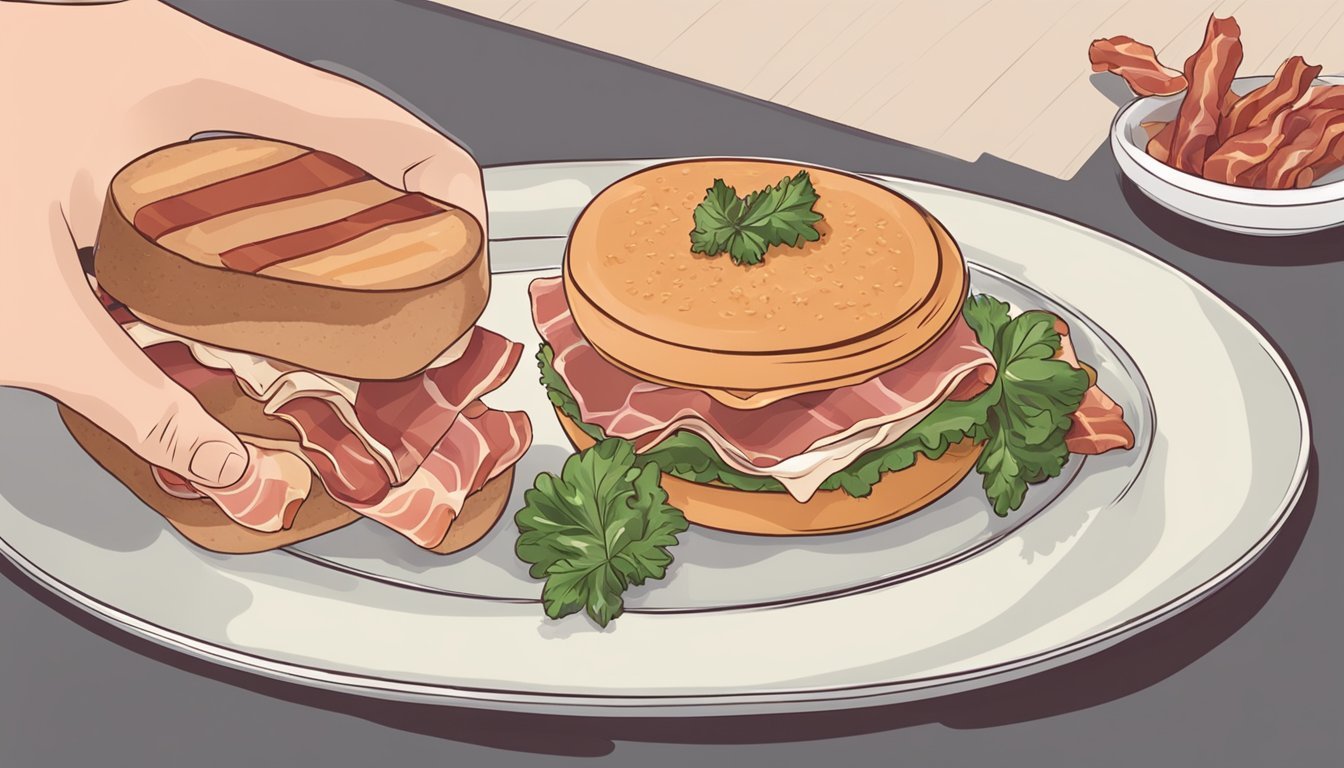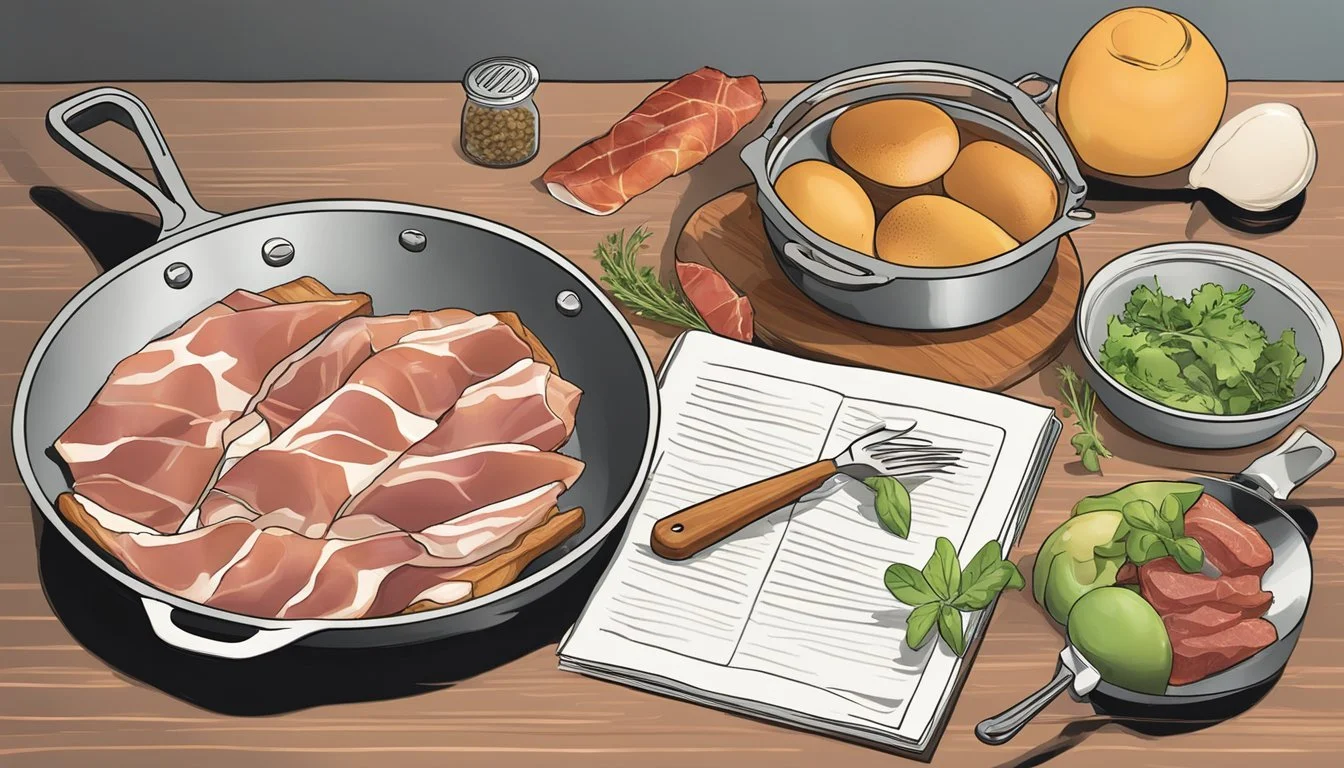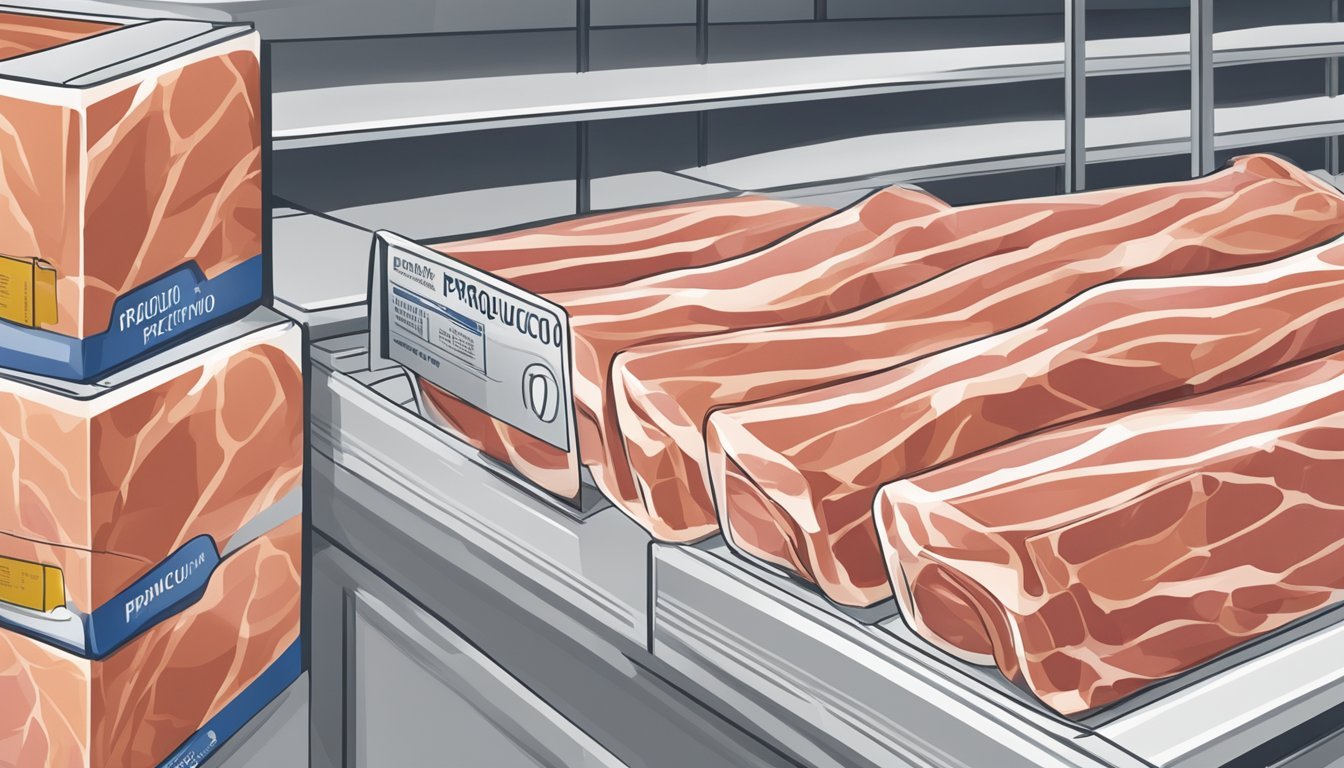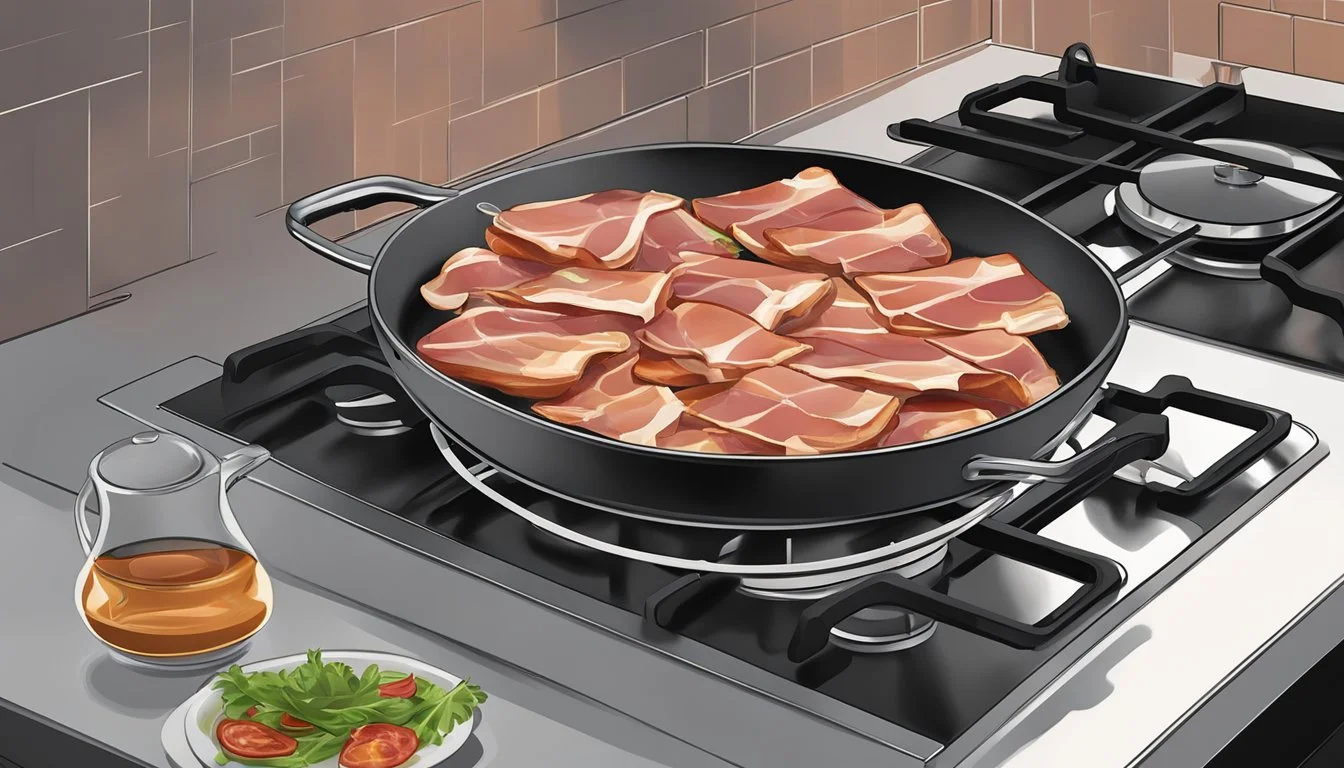How to Substitute Prosciutto for Bacon
A Simple Swap Guide
Substituting prosciutto for bacon (how long does bacon last?) in cooking is a culinary swap that can be made quite seamlessly. Prosciutto, an Italian dry-cured ham, offers a different flavor profile compared to the smoky and crispy nature of bacon, but it can fulfill a similar role in various dishes. The key is understanding the characteristics of each and how they influence the overall dish. Prosciutto is typically seasoned and cured for a longer period, giving it a salty, rich taste with a delicate texture, quite unlike the fatty and hearty crunch of bacon.
When employing prosciutto as a bacon substitute, it is important to adjust for its delicateness and stronger flavor. Prosciutto can be added to pasta dishes, salads, and sandwiches, offering a touch of saltiness and sophistication without overpowering the other ingredients. In recipes that usually call for bacon to add a depth of flavor, prosciutto should be used more sparingly due to its intense taste. Furthermore, it is particularly advantageous in recipes requiring less cooking time, as prosciutto does not need to cook as long as bacon does to reach its ideal texture and flavor release.
The consideration of health can also influence the decision to use prosciutto as a bacon substitute. Generally, prosciutto contains less sodium compared to bacon, making it a more suitable option for those looking to reduce their salt intake. While bacon is known for its high fat content and longer cooking times to achieve a crisp texture, prosciutto offers a lower-fat alternative that can be enjoyed in thin slices without additional cooking, providing a sophisticated twist on traditional bacon flavors in a dish.
Understanding Prosciutto and Bacon
Prosciutto and bacon are popular forms of cured meat, both derived from pork. They offer unique flavors and textures, generally influenced by their distinct curing processes.
Prosciutto is an Italian dry-cured ham, typically sliced thinly. Its curing process involves salting the meat and leaving it to dry for up to 24 months in controlled conditions. This air-drying technique draws out moisture, concentrating the meat’s flavor and giving it a tender texture. Prosciutto usually has a high salt content, with its taste more delicate and less salty compared to bacon.
Bacon, on the other hand, is often cured and smoked, providing it with a robust and smoky flavor. American bacon comes from the pork belly (What wine goes well with pork belly?) , while in other parts of the world, such as the UK, it's cut from the back. After curing in salt, sometimes with sugar and spices, bacon undergoes smoking which imparts the meat with a strong taste profile. Bacon necessitates cooking before consumption, unlike prosciutto which can be eaten uncooked due to its thorough curing.
Cured Meat Curing Process Flavor Typical Use Prosciutto Dry-cured, air-dried Delicate, slightly salty Consumed raw, often as appetizer Bacon Wet or dry-cured, smoked Smoky, rich Cooked, common in breakfast dishes
Though prosciutto is leaner with visible streaks of fat, it tends to have less overall fat content than bacon. Their textural differences are notable— while prosciutto melts in the mouth, bacon offers a crispy bite when cooked. Considering these aspects is essential when substituting prosciutto for bacon in recipes, as it will impact both the dish’s flavor and texture.
Comparing Prosciutto and Bacon Flavors
In this section, we explore the distinctive flavor profiles and textural characteristics that define prosciutto and bacon, two popular cured meats (What wine goes well with cured meats?).
Flavor Profiles
Prosciutto is known for its sweet and savory taste with a richness that comes from the extensive curing process, typically lasting from 1 to 2 years. It exhibits a milder, less salty flavor compared to bacon. In contrast, bacon is heralded for its intense smoky flavor and higher salt content. The flavor is due to the spices and smoking process during production, which imparts a deeper, more robust taste.
Prosciutto Flavor Notes: Sweet, Savory, Mildly Salty
Bacon Flavor Notes: Smoky, Salty, Rich
Texture and Fat Content
The texture of prosciutto is tender and smooth, mainly because it is usually served thinly sliced and uncooked, allowing its delicate structure to be appreciated. Its fat content is visible in thin streaks, providing just a touch of richness without overwhelming the palate. Bacon, on the other hand, has a higher fat to meat ratio, giving it a crispier texture when cooked. The flavors are released and intensified as the fat renders down during the cooking process.
Prosciutto Texture: Tender, Smooth
Bacon Texture: Crispy when cooked
Prosciutto Fat Content: Less fat, subtle richness
Bacon Fat Content: More fat, prominent in flavor and texture
Choosing the Right Substitute
When substituting prosciutto for bacon, one must consider both the desired texture and flavor profile as well as how the substitute will be used in the dish.
Factors to Consider
Selecting a substitute for prosciutto is not merely a matter of replacing one ingredient with another; it involves considering several factors to ensure that the alternative complements the intended dish. The texture and flavor of prosciutto are distinct, with a delicate yet slightly salty taste and a fine, melt-in-your-mouth feel that often contrasts with the chewier and smokier character of bacon.
Texture: A substitute should have a similar thinness and ability to either crisp up or remain tender, akin to prosciutto.
Flavor: Look for substitutes with a balanced saltiness and richness; avoid overpowering smoky flavors if aiming for authenticity.
Italian authenticity: For dishes requiring an Italian touch, select Italian cured meats for consistency.
Raw or cooked: Determine whether the recipe requires the prosciutto to be eaten raw or cooked, as this affects the choices.
Best Uses in Dishes
The way a substitute for prosciutto integrates into a dish depends greatly on the composition and cooking method of the recipe.
Cooked applications: For dishes where prosciutto is cooked, options like pancetta can be appropriate, as cooking will render its fat, enhancing the dish's flavor and texture.
Raw presentations: In settings where prosciutto is meant to be enjoyed raw, such as in antipasti, consider using cured meats that are safe and palatable when not cooked, like culatello.
It's important to align substitutes closely with the role prosciutto plays in the recipe to achieve a harmonious result that respects the balance of the dish's original intent.
Substitution Techniques
Substituting prosciutto for bacon involves careful consideration of saltiness and fat content to achieve the desired flavor and texture in a dish. Prosciutto, being a dry-cured ham, can replace bacon effectively if adjustments are made to account for its saltier profile and different fat characteristics.
Adjusting Saltiness
Prosciutto is known for its higher salt content due to the curing process involving sea salt. When substituting for bacon, the chef may need to reduce other sources of salt in the recipe to maintain a balanced flavor profile. It is important to taste as you go and adjust accordingly.
Taste Test: Begin with a small amount and adjust.
Salt Reduction: Cut down on any added salts in the recipe.
Managing Fat Content
The fat content of prosciutto is generally lower than that of bacon, which affects both the texture and the way it cooks. For dishes where bacon's fat is integral to the cooking process, such as when rendering fat for a sauce, one may need to supplement with a small amount of oil or butter.
Added Fats: Introduce olive oil or butter if necessary.
Cooking Technique: Prosciutto should be cooked over lower heat to prevent drying out, as it is thinner and less fatty than bacon.
To substitute prosciutto for bacon, one should slice the prosciutto thinly to mimic the texture of cooked bacon and monitor the cooking process closely as prosciutto will crisp up faster due to its thinner slices.
Recipes and Applications
When substituting prosciutto for bacon, it’s important to consider the texture and saltiness it brings to different dishes. Prosciutto's delicate nature makes it an excellent addition to recipes where a lighter flavor is desired.
Pastas and Pizzas
In pasta dishes, prosciutto adds a depth of flavor without overpowering the palate. For example, a classic Carbonara can be made by lightly frying thin slices of prosciutto until they are just crisp. This provides a lighter alternative to bacon while still offering the satisfying savory element.
Pizza Toppings: Layering prosciutto atop a pizza adds a refined twist.
Ingredients: Consider pairing with cheese such as mozzarella or goat cheese, fresh herbs, and vegetables like mushrooms and garlic.
Salads and Appetizers
Prosciutto serves as a sophisticated ingredient in salads and appetizers (What wine goes well with appetizers?). It pairs well with fresh greens, providing a balance of saltiness to the dish.
Salads: Incorporate thinly sliced prosciutto with arugula and shave Parmesan cheese for a simple yet elegant salad.
Appetizers: Wrap slices of prosciutto around melon or figs for a classic antipasto.
Sandwiches and Wraps
Prosciutto can elevate sandwiches and wraps, offering a less fatty option compared to bacon. Its flavor marries well with various bread, cheeses, and condiments.
Sandwich Combos:
Rye or sourdough bread
Soft cheeses like brie or cream cheese
Condiments: Mustard, honey, or a touch of balsamic glaze
The use of spices should be judicious as prosciutto is already flavorful; a little goes a long way.
Additional Prosciutto Substitutes
When seeking alternatives to prosciutto, one may prioritize flavor profile and texture. The following meats offer comparable qualities that can complement dishes in a similar fashion.
Pancetta and Capicola
Pancetta, often referred to as Italian bacon, provides a rich, salty flavor similar to prosciutto but with a fattier content. It is cured and typically cooked to render its fat, enhancing its taste and texture. Capicola is another Italian cured meat that's seasoned and dry-cured, offering a delicate balance of meaty and spicy notes suitable for sandwiches and antipasti platters.
Turkey Bacon and Other Meats
For a lower-fat option, Turkey Bacon can act as a stand-in for prosciutto. It has a smokier edge and a texture that crisps up when cooked. Other notable prosciutto substitutes include Salami, with its robust garlic and pepper flavor; Culatello, a leaner choice with a delicate, sweet taste; and Guanciale, an Italian bacon made from pork cheek, beloved for its rich and slightly spicy flavor.
Pairing Prosciutto Substitutes
When choosing substitutes for prosciutto, one must consider how they will pair with other ingredients. The right pairing can elevate the taste and sophistication of an appetizer or snack.
With Wine and Cheese
Wine: A crisp white wine or a light-bodied red wine complements the salty flavor of prosciutto substitutes. For a white, consider a Pinot Grigio or a Sauvignon Blanc. If one prefers red, a Chianti or Pinot Noir offers a delightful balance to the umami in prosciutto alternatives like pancetta or bacon.
Cheese: Pairing with cheese offers an opportunity to balance the savory notes of prosciutto substitutes. Opt for bold cheeses such as Parmesan, Romano, or Asiago. These cheeses' nutty and salty flavors harmonize well with pancetta or bacon, mimicking the umami blend in dishes that would typically feature prosciutto.
Wine Pairings:
White Wine: Pinot Grigio, Sauvignon Blanc
Red Wine: Chianti, Pinot Noir
Cheese Pairings:
Bold Cheeses: Parmesan, Romano, Asiago
With Fruits and Vegetables
Fruit: With their natural sweetness, fruits such as melon or figs balance out the saltiness of prosciutto substitutes. When bacon, for example, is used in lieu of prosciutto, pairing it with cantaloupe or honeydew offers a refreshing contrast.
Vegetables: For a more savory pairing, vegetables can be an excellent complement. Asparagus or brussels sprouts (how long do brussels sprouts last?), when lightly roasted and paired with a prosciutto substitute like bacon, create a delightful appetizer that pairs nicely with many types of nuts for added crunch and flavor depth.
Fruit Pairings:
Melon: Cantaloupe, Honeydew
Other Fruits: Figs
Vegetable Pairings:
Asparagus
Brussels Sprouts
Nuts: Almonds, Walnuts
Health and Nutritional Considerations
When substituting prosciutto for bacon, individuals may consider several health and nutritional points. Prosciutto is generally regarded as the healthier option due to its lower saturated fat content. Specifically, prosciutto contains less saturated fat than bacon, which reduces the risk associated with increased insulin resistance and cardiovascular diseases.
Sodium Content:
Prosciutto: Two slices contain approximately 690 milligrams of sodium.
Bacon: One hundred grams can contain up to 1,717 milligrams of sodium.
Saturated Fat:
Bacon: Higher in saturated fat, which is linked to heart disease.
Moreover, both prosciutto and bacon are cured meats, meaning they are high in sodium which should be moderated in the diet. However, as bacon is a form of red meat predominantly consumed from pork, it typically bears a higher saturated fat level which may contribute to health issues when consumed excessively.
The flavor profiles of these meats are distinct; bacon is known for its smoky flavor and crispness, typically achieved through cooking, while prosciutto offers a more delicate umami flavor due to its extensive curing process, and is often eaten raw.
It is also worth noting that both meats provide a savory, meaty boost to dishes. However, due to the curing process, prosciutto may be a slightly better option for those looking to reduce their intake of smoked or heavily processed meats. As with any dietary recommendation, moderation is key, and considering individual health conditions and nutritional needs is essential.
Historical Context and Origins
Prosciutto, an Italian delicacy, stands as a testament to the country's rich culinary traditions. Originating from Italy, the term "prosciutto" refers specifically to an air-cured ham, emphasizing a legacy of cured meat that is inherently Italian. This air-dried approach to preserving pork has been a part of Italian food (What wine goes well with Italian food?)culture for centuries.
Prosciutto:
Origin: Italy
Curing Process: Air-dried
Part of Pig: Hind leg or thigh
In Italy, the history of making prosciutto can be traced back to ancient Roman times. The Italians perfected the art of curing the hind leg of the pig without the use of smoke, a process distinct from bacon which typically involves smoking. Italian prosciutto is known for this unique curing process which contributes to its delicate flavor and texture, as opposed to the more robust flavor of smoked meats (What wine goes well with smoked meats?).
Curing Methods:
Prosciutto: Air-drying, salting
Bacon: Smoking, sometimes curing
The air-drying method involves salting the ham and then leaving it to dry for an extended period in a controlled environment. This technique utilizes natural processes to both preserve the meat and develop its flavors. The result is a cured meat that highlights the traditional and natural flavors of the pork, distinct from the smokiness of bacon.
Italians pride themselves on their prosciutto, with some regions having attained Protected Designation of Origin (PDO) status to ensure authenticity and quality. The reverence for prosciutto within Italian culture attests to its significant historical roots and the consistent methods that make it a cherished food item in both Italy and around the world.
Preservation and Storage Tips
When substituting prosciutto for bacon, it is important to understand the differing preservation and storage needs of these two types of cured meats. Prosciutto, a dry-cured ham, requires specific conditions.
Uncooked Prosciutto:
Store uncooked prosciutto in the refrigerator, where it will keep for up to 2 months.
It should be kept wrapped in paper or in a cloth bag to protect it from moisture and air exposure.
If sliced, place it between sheets of parchment paper, and store in an airtight container.
Cooked Prosciutto:
Once cooked, prosciutto's shelf life reduces significantly.
Consume within a few days, and store it in the fridge in an airtight container.
Practical Tips:
Avoid prolonged air exposure for both uncooked and cooked prosciutto to prevent it from drying out.
Ensure prosciutto is stored away from strong-smelling foods, as it can absorb odors.
Storage Method Duration Notes Refrigerator (uncooked) Up to 2 months Wrap well to minimize air and moisture. Refrigerator (cooked) 3-5 days Keep in an airtight container.
Always remember that time is a crucial factor in preserving the flavor and safety of prosciutto, whether it is dried or cured. By following these guidelines, one can maintain the quality and extend the life of prosciutto effectively.
Conclusion
When substituting prosciutto for bacon, one can expect to deliver similarly satisfying results with a few nuanced differences. Prosciutto, a salt-cured Italian ham, offers a less fatty and often more complex flavor profile compared to bacon. Its texture and taste can elevate dishes with a more refined touch.
For those looking to switch up their cooking, using prosciutto can be an excellent decision. It crisps up nicely when cooked, though it tends to do so more quickly than bacon due to its thinness. Cooks should monitor it closely to avoid burning.
As a rule of thumb, substitute prosciutto in recipes where bacon's smoky flavor is not the centerpiece. The following table simplifies the substitution process:
Application Bacon Prosciutto Pasta Dishes Adds a smoky richness Offers a saltier, more delicate flavor Salads Provides crunch Contributes a softer texture Sandwiches Brings heartiness Enhances with a touch of gourmet
For a cut of meat that is both flavorful and versatile, prosciutto serves as an impressive substitute that can tweak recipes to potentially healthier proportions. With its distinct cured essence and rustic Italian roots, this alternative gracefully complements ingredients, inviting a touch of Mediterranean sophistication to any meal.












